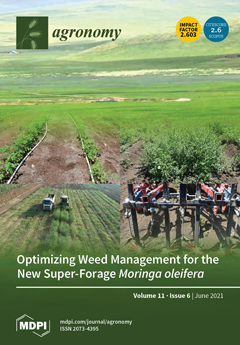Abiotic factors in nutrient solutions (NSs), such as salinity and high electrical conductivity (EC), may adversely alter plant growth and crop performance. However, there are medicinal/aromatic plants which can not only withstand these adverse conditions, but which can also increase their productivity or
[...] Read more.
Abiotic factors in nutrient solutions (NSs), such as salinity and high electrical conductivity (EC), may adversely alter plant growth and crop performance. However, there are medicinal/aromatic plants which can not only withstand these adverse conditions, but which can also increase their productivity or even enhance their quality in such conditions. As fresh water sources suitable for irrigation are becoming more and more limited, the use of low-quality water sources and hydroponic growing systems have been suggested as the main alternatives. Towards that direction, this study aims to evaluate the effect of high EC levels in NSs on geranium (
Pelargonium graveolens L’Hér.) and common verbena (
Verbena officinallis L.) plants cultivated in a soilless (perlite) hydroponics system. Plants were irrigated with a full nutrient solution of EC 2.1 dS m
−1 and pH 5.8 until they reached a uniform size. Then, three treatments were applied, namely: (a) a control treatment with an EC of 2.1 dS m
−1 in the NS, (b) a high-salinity NS created by adding 75 mM of NaCl (EC under 8.5 dS m
−1) and (c) a concentrated NS with an EC of 8.5 dS m
−1. In pelargonium, high salinity decreased the total phenolic and total flavonoid contents; antioxidant capacity; N, K, Mg and P content; as well as chlorophyll fluorescence, compared to the control treatment. On the other hand, increased salinity levels increased the Na and Ca content and stomatal resistance. In common verbena, salinity decreased total phenolic content and chlorophyll fluorescence but increased total flavonoid content; antioxidants; leaf K, P, Na, Cu and Zn content; and stomatal resistance, compared to the control. In both species, high EC did not affect polyphenols, flavonoids or antioxidants, whereas it increased stomatal resistance and nutrient accumulation in the leaves, and decreased chlorophyll fluorescence compared to the control treatment. Damage indices, indicated by lipid peroxidation, hydrogen peroxide production and the elevation of enzymes’ antioxidant activities, were evidenced in both saline- and high-EC-treated plants. In conclusion, despite having the same EC levels in the nutrient solution, it seems that ionic stress caused by high mineral concentrations in the nutrient solution had less severe effects on the tested plants than the relevant osmotic stress caused by high salinity due to the addition of NaCl in the nutrient solution.
Full article





